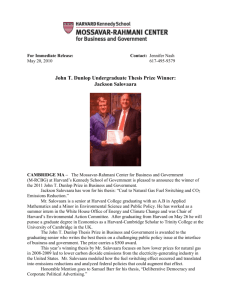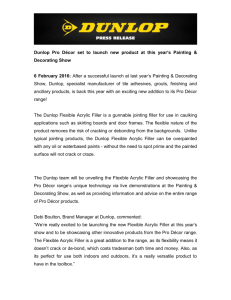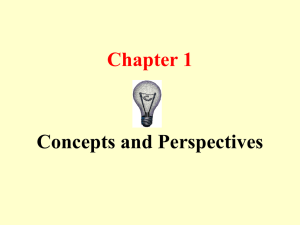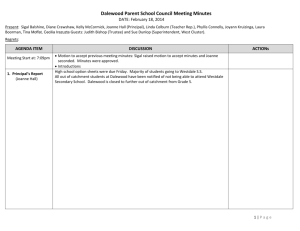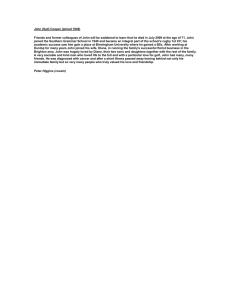T J T. D L
advertisement
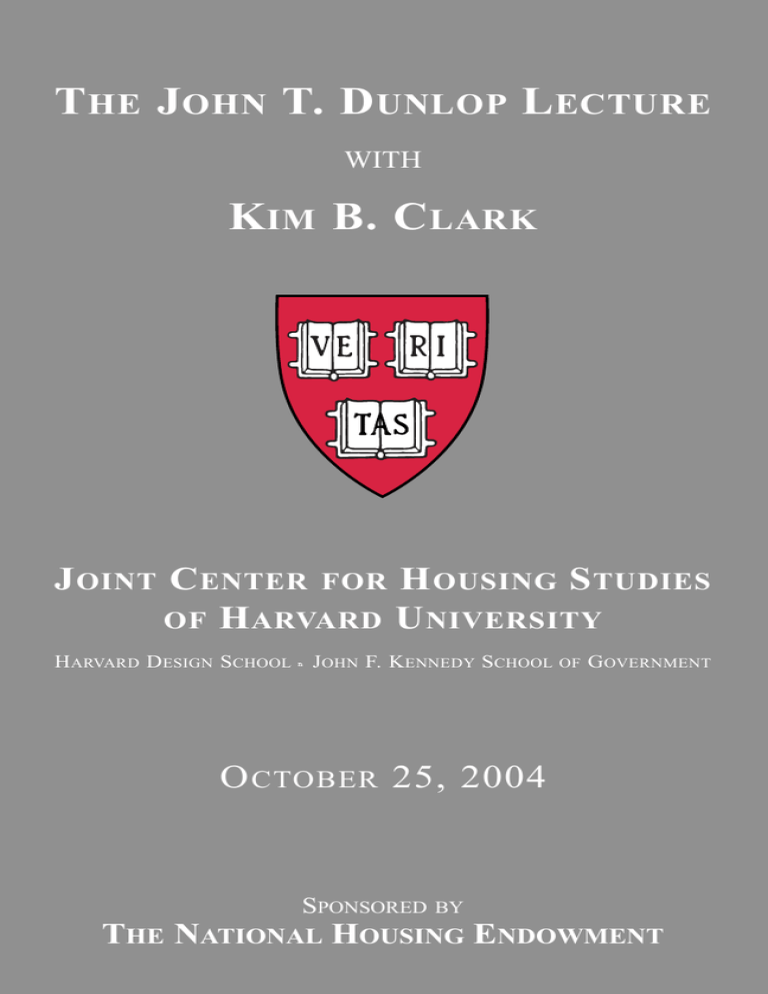
T HE J OHN T. D UNLOP L ECTURE WITH K IM B. C LARK J OINT C ENTER FOR H OUSING S TUDIES OF H ARVARD U NIVERSITY HARVARD DESIGN SCHOOL JOHN F. KENNEDY SCHOOL OF GOVERNMENT n O CTOBER 25, 2004 SPONSORED BY THE NATIONAL HOUSING ENDOWMENT T HE J OHN T. D UNLOP L ECTURE WITH K IM B. C LARK J OINT C ENTER FOR H OUSING S TUDIES OF H ARVARD U NIVERSITY T HE U NIVERSITY AND THE W ORLD OF B USINESS : C REATING D EEP K NOWLEDGE WITH P OWER AND P RACTICE SPONSORED BY THE NATIONAL HOUSING ENDOWMENT THE JOHN T. DUNLOP LECTURE WITH KIM B. CLARK Delivered on October 25, 2004 at the Harvard Design School, Piper Auditorium. Sponsored by the National Housing Endowment. Copyright © 2004 by the President and Fellows of Harvard College. No part of this text may be reproduced, stored in a retrieval system, or transmitted in any form or by any means - electronic, mechanical, photocopying, recording, or otherwise - without the permission of Harvard Business School. Any opinions expressed do not necessarily represent the views of Harvard University, the National Housing Endowment, or of any of the persons or organizations providing support to the Joint Center for Housing Studies. Established in 1959, the Joint Center for Housing Studies is a collaborative unit affiliated with the Harvard Design School and the Kennedy School of Government. The Joint Center illuminates the role of housing in shaping communities and outlines the ways in which housing policy and practices are shaped by economic and demographic trends. Through research, education, and public outreach programs, the Joint Center informs debate on critical housing issues and provides leaders in government, business, and the non-profit sector with knowledge and tools for formulating effective policies and strategies. TABLE OF CONTENTS History of the John T. Dunlop Lecture . . . . . . . . . . . . 1 Biography of Kim B. Clark . . . . . . . . . . . . . . . . . . . . . 7 The University and the World of Business: Creating Deep Knowledge with Power and Practice Kim B. Clark, Dean, Harvard Business School . . . . . . . . . . . . . . 9 HISTORY OF THE JOHN T. DUNLOP LECTURE AT HARVARD UNIVERSITY The John T. Dunlop Lecture commemorates the life and work of the late John T. Dunlop, Lamont University Professor Emeritus of Harvard University from 1985 to 2003 and United States Secretary of Labor during the Ford administration. In a lifetime career dedicated to improving labor-management relations, Professor Dunlop's skillful arbitration and negotiation led to celebrated dispute resolutions in academia, industry, and government. Professor Dunlop was also a widely respected leader in the nation's housing and construction related industries. In 1970, he played a key role in establishing the Policy Advisory Board of Harvard's Joint Center for Housing Studies. Under his guidance, this board of housing industry leaders, through the Joint Center, significantly helped to shape U.S. housing policy and to advocate for measures to insure quality homes for all Americans. SIXTH ANNUAL JOHN T. DUNLOP LECTURE 1 Joint Center director Nicolas P. Retsinas remarked: "John Dunlop was a master bridge-builder. He consistently connected the academy with industry. His insights and his integrity served him well in both worlds. The Joint Center for Housing Studies…is a lasting legacy to his perseverance and to his dedication to informed public policy." Professor Dunlop was chairman of the Construction Industry Stabilization Committee from 1971-1974, and was instrumental in establishing the National Institute for Building Sciences. He served on the board of the National Housing Endowment and in 1986 was inducted into the National Housing Hall of Fame by the National Association of Home Builders. In 1999, the Joint Center for Housing Studies partnered with the National Housing Endowment and the Harvard Design School to create a named lecture that would serve as a lasting tribute to Professor Dunlop and his many contributions to the national housing community. The John T. Dunlop Lecture was established and would bring a housing leader to the university each year to highlight the importance of housing as a policy and research area. The sixth speaker in this honored tradition is Kim B. Clark, Dean of Harvard University Graduate School of Business. Previous lectures have been delivered by the following distinguished housing and community leaders: 2 SIXTH ANNUAL JOHN T. DUNLOP LECTURE HENRY G. CISNEROS (September 29, 2003) Homes for Americans in the 21st Century: Challenges and Opportunities for the Nation ANGELO R. MOZILO (February 4, 2003) The American Dream of Homeownership: From Cliché to Mission HERBERT V. KOHLER, JR (October 29, 2001) Designing Form and Function in the American Home BARBARA T. ALEXANDER (October 12, 2000) The U.S. Homebuilding Industry: A Half-Century of Building the American Dream KENT W. COLTON (May 4, 1999) Housing at the Millennium The lecture honors Professor Dunlop's accomplishments as a scholar and administrator. He began his Harvard career in 1938, becoming associate professor of economics in 1945 and full professor in 1950. He chaired the Economics Department from 1961 to 1966, and while serving as dean of the Faculty of Arts and Sciences from 1969 to 1973, led the faculty-student University Committee on Governance. He was appointed Lamont University Professor in 1971. During his tenure at Harvard, Professor Dunlop was instrumental in founding many academic programs, including the Trade Union Program (now the Labor and Work Life Program), the Ph.D. Program in Business and Economics, and the Program in Business and Government. At a 2003 memorial service, Harvard President Lawrence H. Summers commented: "John Dunlop was a towering SIXTH ANNUAL JOHN T. DUNLOP LECTURE 3 figure in Harvard's history. As a scholar, dean, secretary of labor, and an adviser to countless institutions, John Dunlop was a major contributor to the life of our nation and to our university." Professor Dunlop's leadership extended into his government service. In addition to serving as secretary of labor from March 1975 to January 1976, he served as an adviser to many United States presidents beginning with Franklin D. Roosevelt. His many government posts included director of the Cost of Living Council (1973-74), chair of the Commission of the Future of Worker/Management Relations (1993-95), chair of the Massachusetts Joint Labor-Management Committee for Municipal Police and Firefighters (1977-2003), and chair of the Commission on Migratory Farm Labor (1984-2003). Professor Dunlop's numerous books and articles advanced the understanding of labor relations. His contributions included: Wage Determination Under Trade Unions (1944); Collective Bargaining: Principles and Cases (1949); Industrial Relations Systems (1958); Labor in the Twentieth Century (ed., 1978); Dispute Resolution, Negotiation and Consensus Building (1984); and A Stitch in Time: Lessons from the Apparel and Textile Industries (with Abernathy, Hammond, and Weil, 1999). Professor Dunlop's impact was vast and profound. Former Harvard president Derek Bok said of his colleague: "John Dunlop led a remarkable life. As a teacher, he helped develop generations of labor economists. As a scholar, he 4 SIXTH ANNUAL JOHN T. DUNLOP LECTURE was a leading figure in furthering our understanding of labor markets and institutions. As a practitioner, he played an indispensable role in finding common ground between labor unions, employers, and government." SIXTH ANNUAL JOHN T. DUNLOP LECTURE 5 BIOGRAPHY OF KIM B. CLARK Kim B. Clark, Dean of the Faculty at Harvard Business School, is also the George F. Baker Professor of Administration. A member of the Harvard faculty since 1978, Professor Clark received B.A. (1974), M.A. (1977), and Ph.D. (1978) degrees in economics from Harvard University. Professor Clark's research is focused on modularity in design and the integration of technology and competition in industry evolution with a particular focus on the computer industry. He and Carliss Baldwin are co-authors of a new book on the topic entitled Design Rules: The Power of Modularity (MIT Press, 2000). Earlier research has focused on the areas of technology, productivity, product development, and operations strategy; publications on these topics include: Leading Product Development: The Senior Manager's Guide to Creating and Shaping the Enterprise (with S.C. Wheelwright, Free Press, 1995); The Perpetual Enterprise Machine: Seven Keys to Corporate Renewal SIXTH ANNUAL JOHN T. DUNLOP LECTURE 7 through Successful Product and Process Development (coedited with H.K. Bowen, C. Holloway, and S.C. Wheelwright, Oxford University Press, 1994); and Revolutionizing Product Development (with S.C. Wheelwright, The Free Press, 1992). A comprehensive study on product development in the world auto industry (with T. Fujimoto), Product Development Performance, was published in 1991 by HBS Press. Other books include Dynamic Manufacturing (with R.H. Hayes and S.C. Wheelwright, Free Press, 1988) and Industrial Renaissance (with W.J. Abernathy and A.M. Kantrow, Basic Books, 1983). Recent publications include “Managing in an Age of Modularity” (with C.Y. Baldwin, Harvard Business Review, September-October 1997), “Development Projects: The Engine of Renewal” (with H.K. Bowen, C.A. Holloway, and S.C. Wheelwright, Harvard Business Review, September-October 1994), “Organizing and Leading “Heavyweight” Development Teams” (with S.C. Wheelwright, California Management Review, Spring 1992), “Capabilities and Capital Investment: New Perspectives on Capital Budgeting” (with C.Y. Baldwin, Journal of Applied Corporate Finance, 1991), and “The Power of Product Integrity” (with T. Fujimoto, Harvard Business Review, November-December 1990). By birth, Kim Clark is a westerner, having grown up in Washington and Utah. He and his wife, Sue, live in Belmont, Massachusetts. They are the parents of seven children and six grandchildren. Professor Clark is an avid golfer. 8 SIXTH ANNUAL JOHN T. DUNLOP LECTURE T HE U NIVERSITY AND THE W ORLD OF B USINESS : C REATING D EEP K NOWLEDGE WITH P OWER AND P RACTICE It is a pleasure to be here tonight to give the 6th Annual John T. Dunlop Lecture. I am grateful to the Joint Center for Housing Studies and the National Housing Endowment for hosting this event. I am honored to be with you, especially this year when we remember John's life and work. John Dunlop played a very important role in my life and it has been a pleasure to reflect on our relationship and what I have learned from him. I would like to talk tonight about the University and the world of business, and about the challenge of creating deep knowledge with power in practice. In so doing I will talk about John, what I learned from him, and how it has shaped my work. In important ways I have walked in some--not all--of his footsteps. I was his student. I worked for him in Washington when he was Secretary of Labor. He guided my doctoral dissertation and was instrumental in introducing me to the Harvard Business School (HBS). Today, I too serve as dean of a school at Harvard that aspires to create deep knowledge with power in practice. In John's approach to research I find fundamental principles that have guided my SIXTH ANNUAL JOHN T. DUNLOP LECTURE 9 work--that shape what we are doing at HBS. Tonight I would like to share those principles with you, illustrate them from my work, and close with some thoughts about my part of the University. Along the way I hope you will find the ideas of value in your own work. First, a word about John. John Dunlop was a man of many talents. He was a mediator, a policy maker, a regulator, a man for all times of the day and night: the Lamont University Professor at Harvard, dean of the Faculty of Arts and Sciences, Secretary of Labor, and much else. He did all these things with great skill and in his own unique way. John Dunlop was also a great scholar. His scholarship, from the very beginning of his academic career, was distinctive. Throughout his life John sought to connect the world of the academy to the world of practice. He was at home in both, and he sought to bring them together. In his 1950 book, Wage Determination Under Trade Unions, John included a quote from Alfred North Whitehead that captures the very essence of John Dunlop as a scholar: All the world over and at all times there have been practical men, absorbed in irreducible and stubborn facts. All the world over and at all times there have been men of philosophic temperament who have been absorbed in the weaving of general principles. It is the union 10 SIXTH ANNUAL JOHN T. DUNLOP LECTURE of passionate interest in the detailed facts with equal devotion to abstract generalization which forms the novelty in our present society.1 John's passion for facts and his devotion to generalization was evident in one of his very first published papers. In 1938, while a graduate student on a fellowship for a year in Cambridge, England, John published in the Economic Journal what would become a very famous paper. I won't give you a full treatment here tonight. In a nutshell, John--a lowly graduate student--took issue with the great John Maynard Keynes. In contrast to the model Keynes developed in the General Theory, Dunlop showed that real wages are not countercyclical, but rather move with the economic cycle. You will have to take my word for it, but this question was, and still is, at the heart of understanding macroeconomics. In any case, what matters for us is how John arrived at his conclusions. Let me read to you a description of his methods that John wrote some 60 years after the fact: …my article drew upon an extensive review of periodic reports over many years for British trade unions, trade newspapers such as the "Cotton Factory Times," government reports, 1Whitehead, Alfred North. Science and Modern World, pp. 3-4. Quoted in John T. Dunlop. Wage Determination Under Trade Unions (Augustus M. Kelley, New York, 1950) SIXTH ANNUAL JOHN T. DUNLOP LECTURE 11 publications of employer associations, minutes of negotiations, arbitrators' decisions and numerous interviews with employers and trade union officials over wage rate policy and decisions. 2 John used published data in his study, but he was not content with that. He went into the field and interviewed decisionmakers. He sought to understand decisions on wages and the context in which those decisions were made. He wanted to know the way actual people working in actual institutions took action on wages so that he could understand in a deeper way what he was seeing in the published data. There are important principles here, principles that help drive the research deep, but also give it power in practice. Research of the kind John did in the 1930s is not driven by arcane concerns, but by real problems; it is directed at deep understanding that will be useful in taking effective action; it is grounded in facts and data and informed by knowledge of the context in which action takes place; and while it goes after depth and detail, its purpose is to see the larger whole and come to broader conclusions. In addition, in John's work we see his preoccupation with understanding how people, technologies, institutions, Dunlop, John T. The Journal of Economic Perspectives, vol. 12, No. 2 (Spring, 1998), p. 226 12 SIXTH ANNUAL JOHN T. DUNLOP LECTURE and markets interact to create a system of relationships that drives performance. All that was in 1938. I first met John in the fall of 1974 when I took his course on Labor Economics and Industrial Relations. Later, I worked for him in Washington where in early morning meetings he would counsel me about my dissertation. I was interested in the effect of unions on productivity, and John gave me great advice. He told me there were two kinds of great dissertations: you either had a great new theory; or you found a unique set of data that addressed an important problem. He told me to go for the latter, and he had the perfect place to find the data: the cement industry. That is how I ended up studying the effects of unions on productivity in the cement industry. I followed the Dunlopian model and went out and collected data, visited plants, and talked to lots of people. Along the way I discovered something totally unexpected that has had a profound effect on my professional life. I call this the "Tale of Two Plants." Let me first show you the data on tons of cement produced per hour of labor for plant 2204. What we are looking at in figure 1 is a measure of labor productivity. SIXTH ANNUAL JOHN T. DUNLOP LECTURE 13 Figure 1: Productivity in Plant 2204 3.50 3.003.00 2.502.50 2.002.00 1.50 1.50 1.00 1.00 0.500.50 0.00 1966 1967 1968 1967 1968 1969 1969 1970 1971 1972 1973 1974 1975 1976 1970 1971 1972 1973 1974 1975 1976 1977 You can see that plant 2204's performance varied between 2.5 to 3.0 tons per hour, with a mild upward trend. Let me add plant 2205 to the figure (figure 2). Plant 2205's performance varied between 1.03 and 2.10 tons per hour with a strong upward trend, at least Figure 2: Productivity in Plant 2204 and 2205 3.50 2204 3.00 3.00 2.50 2.50 2205 2.00 2.00 1.50 1.50 1.00 1.00 0.50 0.50 0.00 1966 1967 1967 1968 1968 1969 1969 1970 1970 1971 1971 1972 1972 1973 1973 1974 1974 1975 1975 1976 1976 until 1975. This means that plant 2204 was something like 75 percent more productive than plant 2205 over this period. 14 SIXTH ANNUAL JOHN T. DUNLOP LECTURE 1977 When I saw this in the data I was shocked. I knew my plants and I knew that these two plants were built in the same year, were the same size, and used the same technology. Moreover, they were both nonunion, and were located about five miles from each other. They hired in the same labor market, sold into the same product market, and competed directly against one another. Everything I had been taught in my economics courses about what drives productivity was identical in these two plants, and yet one of them was far more productive than the other. I visited both of these plants and interviewed their executives. I learned two things: 1) the variation in productivity is indeed much larger than we can explain with conventional economic models; and 2) management matters. Indeed, what I found was large differences in structure, process, relationships, values, and culture. The less productive plant was a classic hierarchical organization with adversarial relationships between supervisors and workers. Today, I would say (I didn't know any of this then) that this plant had poor process control, and suffered from very poor shop floor discipline. The stronger plant had few levels of management, much more discipline, a much clearer sense of purpose, and far better alignment of the workforce with management. It was a much tighter ship, but a much better place to work. This natural experiment got me interested in SIXTH ANNUAL JOHN T. DUNLOP LECTURE 15 understanding management. I saw that effective management could make an enormous difference in performance. And so I embarked on a long study of the relationship between management and productivity. Let me show you one more example from that work that illustrates the process of taking these ideas deeper. I joined the HBS faculty in 1978 and taught Production and Operations Management. I pursued my interests in productivity and technological change, and added a lot of new understanding of management. One of my colleagues, Bob Hayes, and I set out to look at the basic question of the relationship between management and productivity. Let me show you a set of data from one of our studies.3 The measure of productivity here is total factor productivity. It takes into account all the resources used in production, including labor, materials, energy, capital, and so forth. Let me show you Plant 1. As you can see, over the course of five years this plant experienced strong growth in productivity--on the order of 8-10 percent a year. Though there were ups and downs, the performance was strong. u 3 Hayes, Robert H, Steven C. Wheelwright, and Kim B. Clark. Dynamic Manufacturing. New York: Free Press, 1998 16 SIXTH ANNUAL JOHN T. DUNLOP LECTURE 1.2 TFP Index 1.1 1 0.9 0.8 0.7 0.6 1 6 11 16 21 26 31 36 41 46 51 56 61 66 Months Plant 2 has a different pattern. There is almost a step-like progress here. On average, the rate of the growth of productivity was about the same as in plant 1, but the journey was very different. u 1.5 1.4 TFP Index 1.3 1.2 1.1 1 0.9 0.8 0.7 0.6 1 6 11 16 21 26 31 36 41 46 51 56 61 66 Months SIXTH ANNUAL JOHN T. DUNLOP LECTURE 17 Now look at plant 3. There's an upward trend, but performance is very erratic. Over the same five year period there are many periods where performance deteriorates 25-30 percent over the course of a few months, and then rebounds dramatically. u 1.2 1.15 TFP Index 1.1 1.05 1 0.95 0.9 0.85 0.8 0.75 1 6 11 16 21 26 31 36 41 46 51 56 61 66 Months We come to Plant 4, where the story is not happy. Here we see one period of progress sandwiched in u 1.3 1.25 TFP Index 1.2 1.15 1.1 1.05 1 0.95 0.9 0.85 1 6 11 16 21 26 31 36 41 46 51 56 61 66 Months 18 SIXTH ANNUAL JOHN T. DUNLOP LECTURE between two periods of significant decline that lasted over a year. The net effect is very little growth in performance and a highly variable impact on costs over this period. The last plant, plant 5, experienced a massive decline in performance over an 18 month period (TFP dropped about 50 percent). It took the plant over a year to recover back to the level of performance it achieved five years before. u 1.3 1.2 TFP Index 1.1 1 0.9 0.8 0.7 0.6 0.5 0.4 1 7 13 19 25 31 37 43 49 55 61 Months Each of these graphs represents a different production facility, measured over the same period of time. We chose these facilities for study because they all belonged to the same consumer products company, and they all produced the same product (I don't mean similar, I mean literally identical), using exactly the same proprietary production process. What is more, SIXTH ANNUAL JOHN T. DUNLOP LECTURE 19 they were part of the same division, whose management had sought to share best practices among the facilities. When we first showed this data to the senior management of this company they were surprised. There is such wide variation in the behavior of TFP over time that one might think these plants were dealing with vastly different technologies, or very different markets. But as best we could determine, the technical and market contexts were identical. Our research team studied each of these facilities in some depth. We came away with three highly interrelated conclusions: 1) in spite of senior management's efforts at sharing ideas across facilities, each of these plants had a distinctive culture. 2) The high performance culture put a lot of emphasis on what I would call "learning on the line"-responsibility was pushed to the lowest competent level, and management worked hard to emphasize the importance of learning at every level and incorporating learning into the process. 3) The best plants had much more control over the process, knew more about it and had achieved what I would call "dynamic control"--the ability to change the capabilities of the process while meeting strict standards of quality. This meant that the process ran faster, with many fewer problems in the best plants. 20 SIXTH ANNUAL JOHN T. DUNLOP LECTURE Over many years, I have studied the performance of production systems as well as engineering, and product development in cement, consumer products, computers, semiconductors, pharmaceuticals, steel, automobiles, medical devices, chemicals, power tools, food service, and much else. I have looked at performance over time and across companies and countries in North America, Asia, and Europe. All of this work has convinced me that the variation in performance between the best and the worst is far larger than we imagine and far, far, more than conventional theories might explain. Herein lies the great need, the great opportunity in the world of practice, and the great responsibility in the world of the academy. Since the day I saw those two cement plants with their vastly different levels of performance, I have been on a journey to understand the role and power of management in creating organizations with superior performance. Along the way, what John Dunlop taught me has guided my path: work on real problems; search for results that will lead to effective action in practice; get into the field and ground the work in facts and data; pay close attention to the context in which action takes place; go after depth and detail, but always work to see the larger whole and seek for broader conclusions; look for answers in the system of relationships among SIXTH ANNUAL JOHN T. DUNLOP LECTURE 21 people, technologies, institutions, and markets that drives performance. That is what I have tried to do. Now I find myself in charge of a school whose very mission - to educate leaders who make a difference in the world - requires just this kind of scholarship. It is an important and challenging enterprise. Part of its challenge arises from the plain fact that the principles John taught me are not the norm in doctoral programs that train our new faculty. Often the work is narrow, quite abstract and stylized, divorced from the realities of practice and driven not by real problems, but by arcane issues in the discipline (e.g., the functional form of an equation). That is not true of all of it, but it is true enough to make what we want to do a challenge. Over many years we have developed a set of practices designed to help our faculty do the kind of work our mission requires. The school is organized around problem domains and interest groups rather than disciplines or methods. The way we are organized and our approach to recruiting bring to the school scholars trained in a wide variety of disciplines and methodologies. u We encourage our faculty to do research that cuts across established discipline and functional u 22 SIXTH ANNUAL JOHN T. DUNLOP LECTURE boundaries. Our internal funding of research encourages our faculty to be ambitious and to take risks. We place high value on field-based, problemfocused research. The case method helps our faculty get into the field and stay close to practice. Each year we write 350 new field-based cases. u The way we teach and the way we build new knowledge are closely connected. For us, the classroom takes on the character of an idea incubator where we explore with our students difficult, unsolved problems and new ideas for solving them. Likewise, our research often leads to new kinds of courses and new materials that themselves become the focus of intense discussions with our students. u We invest a great deal of time, effort and money in our doctoral programs. In addition to the work we do with the faculty of Arts and Sciences educating doctoral students, we have developed integrative courses in the theory of general management, and courses in field-based methods that are unique to HBS. We encourage the placement of our doctoral students in the very best schools, including HBS. Something like 25 percent of our new hires come from our own doctoral programs. u SIXTH ANNUAL JOHN T. DUNLOP LECTURE 23 In all these ways we encourage the creation of new knowledge that is both deep, and has power in practice. Although much of what we do has roots in practices that began long ago, I have tried to shape our approach to research and its integration with the classroom in my time as dean. In some measure therefore, what John Dunlop believed and taught is part of the Harvard Business School of 2004. Thank you. 24 SIXTH ANNUAL JOHN T. DUNLOP LECTURE
